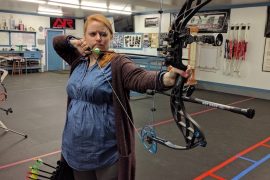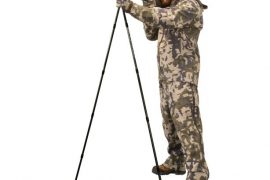
A glimpse of wrist-thick antler, a low growling grunt, and a flagging white tail. For most of us, encounters with giant old whitetail bucks are rare and fleeting. So when we do come across these deer, we often misunderstand them and they slip away.
But GPS-collar research and advanced trail-camera scouting techniques are giving us a clearer view into the secretive lives of mature whitetails. Sure, plenty of studies indicate that deer are individuals. But, a deeper dive—including interviews with experts and a review of countless studies—shows that older bucks can be categorized into personality types. And figuring out a buck’s profile can give you the clues you need to successfully hunt him.

This buck regularly shows up on camera right after other deer arrive at a food source. He displays dominant posture, runs off smaller bucks, and has busted-up tines.
A dominant buck looking for a fight is one of the best types of deer to target, says Dr. Grant Woods, a well-regarded wildlife biologist who specializes in helping landowners set up properties for deer hunting. Woods sets the majority of his cameras to capture video clips of bucks at food plots, salt licks, and other areas where deer congregate because he wants to read individual buck behavior. It’s easier to interpret that behavior through video than it is through a series of photos. The ideal scenario is identifying a mature brawler buck early in the fall.
xanax pills
buy xanax
tramadol buy online
valium buy
Ambien overnight delivery
“When I see a mature buck that is aggressive toward other bucks, I pay attention,” says Woods. “That buck is likely easier to grunt or rattle in. In contrast, when I see a big buck that is always alone and comes in after sunset, I know I have a tough buck to hunt. My time is finite, so why waste my precious hunting days on a buck I might never see? All other things being equal, I’m going after the aggressive buck.”
When you find an aggressive buck, make sure to hunt him hard as soon as weather conditions allow. Brawlers will be vulnerable in the pre-rut phase, and the classic tactic of rattling outside his bedroom can be killer. If you’re not able to bring this buck into bow range early, your neighbor very well might.

This buck will show up one day on all of your cameras at once. Odds are he’ll be cruising through quickly, following a doe, and you’ll only capture fleeting photos of him. Then he’ll disappear for a day or two, and your buddy a couple farms away will have him on his cameras.
Some bucks shift ranges during the fall (we’ll get to that later), but many others go on what wildlife researchers call “excursions.” These are often short (less than 24 hours) walkabouts in which the bucks leave their usual range, likely in search of estrous does.
“Two recent studies in which researchers were following collared bucks showed this tendency,” says Brian Murphy, CEO of the Quality Deer Management Association. “A study of 15 collared bucks in Maryland found that 58 percent of them roamed during the rut. Another study of 16 collared bucks in Texas found that all the bucks went on excursions. Some of these bucks went 8 or more miles in a 24-hour period.”
tramadol buy
tramadol website
In one interesting example, University of Tennessee whitetail researcher Ryan Basinger recorded the first breeding between a wild collared buck and wild collared…




